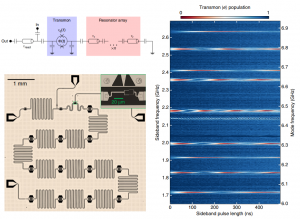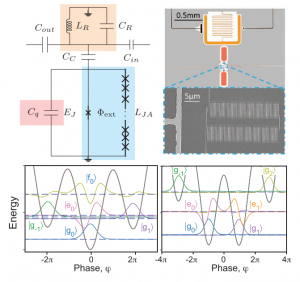Research
Our group’s research is focused on building new quantum information processors and simulators that combine superconducting circuits with high-Q microwave cavities. We build multimode cavity-QED systems that reduce the complexity of quantum information processing and storage by coupling a single or a few superconducting circuits (logical elements) to a spectrum of long-lived 3D cavity modes (memories). These systems are promising for exploring quantum optics approaching the many-body regime, in an inherently non-equilibrium setting with tunable interactions and dissipation. We plan to use these systems to build exotic quantum states of microwave photons, explore different schemes for quantum control and error correction, and develop new hardware that improves on gate fidelities.
Past work on superconducting quantum systems
My postdoctoral research in the group of Dave Schuster at U.Chicago focused on quantum information processing with multimode circuit quantum electrodynamics (multimode cQED). We demonstrated the feasibility of universal quantum computing in this architecture by implementing random access processor in a planar chip. We also developed a general technique for building high-coherence multimode cavities that can be efficiently coupled to superconducting qubits and leveraged the coherence improvements and strong interactions with the superconducting transmon circuit to engineer a new non-local many-body interaction (multimode photon blockade) between microwave photons. The improvements in the coherence and thermal occupations that we achieved for 3D cQED systems also enabled the demonstration of a new scheme for detecting low-mass dark matter by using superconducting qubits as photon counters. In addition, I also helped demonstrate a new superconducting circuit variant called the heavy-fluxonium, and transmon qubits with novel junctions comprised of two-dimensional Van-der Waals materials. A few highlights of this research are detailed below. For more information, please look at our Publications.
-
 Our microwave cavities are typically multimodal, possessing tens of modes with photon lifetimes of a few milliseconds, forming state-of-the-art multimode cavity QED systems when combined with superconducting circuits. We typically build our cavities by what we call the flute method, made by drilling overlapping holes into a monolithic block of superconductors. This naturally eliminates loss from joints and seams, achieving coherences determined only by intrinsic material properties. We use the location and depth of the holes to adjust the cavity mode frequencies and interactions with a superconducting circuit. We recently demonstrated a multimode cavity with 9 operable modes with photon lifetimes ~ 2 ms. With only a single control line, we demonstrate a variety of techniques for universal cavity control, applicable over the entire multimode cavity spectrum.
Our microwave cavities are typically multimodal, possessing tens of modes with photon lifetimes of a few milliseconds, forming state-of-the-art multimode cavity QED systems when combined with superconducting circuits. We typically build our cavities by what we call the flute method, made by drilling overlapping holes into a monolithic block of superconductors. This naturally eliminates loss from joints and seams, achieving coherences determined only by intrinsic material properties. We use the location and depth of the holes to adjust the cavity mode frequencies and interactions with a superconducting circuit. We recently demonstrated a multimode cavity with 9 operable modes with photon lifetimes ~ 2 ms. With only a single control line, we demonstrate a variety of techniques for universal cavity control, applicable over the entire multimode cavity spectrum. -
 We explore techniques for controlling the quantum state of the microwave cavity modes using superconducting circuits. We recently used photon number selective drives on a coupled fixed-frequency transmon to disallow states with a target photon number and implement photon blockade (top left panel). A sufficiently weak cavity drive causes a Rabi oscillation in the presence of the blockade tone and can be used to prepare an arbitrary qubit state in any cavity (see Fock state 1 in the top, right). This scheme can be extended to higher photon numbers to implement a qudit in any cavity mode, where we implemented a new form of universal cavity control involving shaped pulses acting only on the cavity modes. We generalized this control scheme to generate interactions between photons using multimode photon blockade, using it to disallow a manifold of states with the same total photon number (the hyperplane in the bottom, left figure). This implements a non-local N-body interaction between photons, in the presence of which pure cavity drives generate entangled states. The bottom right figure shows the density matrix of a 3-mode W-state prepared by blockading 2 photons and simply simultaneously driving each mode.
We explore techniques for controlling the quantum state of the microwave cavity modes using superconducting circuits. We recently used photon number selective drives on a coupled fixed-frequency transmon to disallow states with a target photon number and implement photon blockade (top left panel). A sufficiently weak cavity drive causes a Rabi oscillation in the presence of the blockade tone and can be used to prepare an arbitrary qubit state in any cavity (see Fock state 1 in the top, right). This scheme can be extended to higher photon numbers to implement a qudit in any cavity mode, where we implemented a new form of universal cavity control involving shaped pulses acting only on the cavity modes. We generalized this control scheme to generate interactions between photons using multimode photon blockade, using it to disallow a manifold of states with the same total photon number (the hyperplane in the bottom, left figure). This implements a non-local N-body interaction between photons, in the presence of which pure cavity drives generate entangled states. The bottom right figure shows the density matrix of a 3-mode W-state prepared by blockading 2 photons and simply simultaneously driving each mode. -
 We implemented a random-access processor in a 2D circuit comprising a chain of strongly coupled coplanar waveguide resonators. The memory bits were stored as photons in the normal modes of the chain, which could all be addressed using a single flux-tunable transmon coupled to one end of the chain. Similar to an FM radio, the transmon was flux modulated at the appropriate frequency to stimulate the exchange of photons/quantum information between the processor (transmon) and the memory (normal modes of the resonator chain. By using higher transmon levels, we also implemented two-qubit gates any pair of cavity modes. Unlike architectures with nearest neighbour interactions, the gates could be performed between arbitrary pairs of modes with equal ease, demonstrating random access.
We implemented a random-access processor in a 2D circuit comprising a chain of strongly coupled coplanar waveguide resonators. The memory bits were stored as photons in the normal modes of the chain, which could all be addressed using a single flux-tunable transmon coupled to one end of the chain. Similar to an FM radio, the transmon was flux modulated at the appropriate frequency to stimulate the exchange of photons/quantum information between the processor (transmon) and the memory (normal modes of the resonator chain. By using higher transmon levels, we also implemented two-qubit gates any pair of cavity modes. Unlike architectures with nearest neighbour interactions, the gates could be performed between arbitrary pairs of modes with equal ease, demonstrating random access. -
 Unlike conventional transmon circuits which are anharmonic oscillators, the fluxonium has an additional parallel inductor that helps realizes a double-well potential, with the qubit formed from the ground state of each well. At the Schusterlab, we (lead by Nathan Earnest) added a shunt capacitance to the original fluxonium design to exponentially suppress the tunneling matrix elements involved in spontaneous energy relaxation. The resulting heavy fluxonium circuit has metastable states with energy relaxation times up to 8 ms, among the highest reported to date in a superconducting circuit. We overcame the strong suppression of direct transitions between the metastable states by realizing a Λ system using a higher fluxonium level and performing fast single-qubit gates via Raman transitions. Lead by Helin Zhang, we recently also developed a new control scheme that uses fast-flux pulses for single-qubit gates. Here the circuit was operated near the degeneracy point, where the T1’s and T2’s exceeded those of standard transmons with comparable single-qubit gate speeds.
Unlike conventional transmon circuits which are anharmonic oscillators, the fluxonium has an additional parallel inductor that helps realizes a double-well potential, with the qubit formed from the ground state of each well. At the Schusterlab, we (lead by Nathan Earnest) added a shunt capacitance to the original fluxonium design to exponentially suppress the tunneling matrix elements involved in spontaneous energy relaxation. The resulting heavy fluxonium circuit has metastable states with energy relaxation times up to 8 ms, among the highest reported to date in a superconducting circuit. We overcame the strong suppression of direct transitions between the metastable states by realizing a Λ system using a higher fluxonium level and performing fast single-qubit gates via Raman transitions. Lead by Helin Zhang, we recently also developed a new control scheme that uses fast-flux pulses for single-qubit gates. Here the circuit was operated near the degeneracy point, where the T1’s and T2’s exceeded those of standard transmons with comparable single-qubit gate speeds.